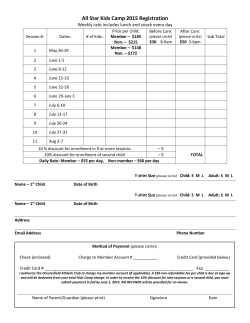
MPDâ 2021 updates
MPD– 2021 updates VOLUME 4 ISSUE 1 8TH MAY 2015 74/4 Land in Delhi - An impediment to Land pooling By Ramesh Menon With the DDA announcing the Land pooling policy, and the implementation of the same likely within a couple of months, it's imperative that the policy makers spare a thought to this one impediment to the planned urbanization of Delhi:Inside this issue: DDA to make farmers aware of Land pooling policy 2 The Land allotted to the Landless in the 1970s, more popularly referred to by the local landowners as “74/4”. Impractical circle rates would compound Land Acquisition 3 A brief history of reference “74/4 land” Real Estate Bill referred to 5 Select committee of Rajya Sabha Should the Government promote Real Estate Industry 5 During the mid 1970, Mrs. Indira Gandhi, the then Prime minister initiated the 20 points programme with the intent to provide succor & uplift the poor & underprivileged sections of the society. The then government allotted agricultural land, largely from the Gram sabha account, to the landless farmers from the weaker sections of society, so that the recipients could create subsistence farming. The same was done in the villages of Delhi too, and there are multiple acres under various villages which have passed on from one generation to another, and the same is referred to as “74/4” land. (Only the physical possession remains within the family, although there are no documents to prove otherwise). Although the said scheme was discontinued in 1989, and no more such allotments were made thereafter, there is substantial confusion about the sta- tus of these lands, allotted then. (Although, it is acknowledged that the purpose of the scheme was achieved by drawing parity amongst the castes & landholders amongst the villages) The government, over the past decade & a half has acknowledged that forward-looking decision(s) need to be taken about the status of these lands, in the everurbanizing landscape of Delhi. The necessary action thereof from the government, were taken up for discussion multiple times by the Delhi assembly; various committees appointed for fact finding & grievance redressal*, as well as the various competent authorities to ascertain the following facts: * Suggestions / Objections / Opinions & grievances were sought from the general public solicited through advertisements in leading dailies Allotment of residential/agricultural land under 20 Point Programme Conferment of title/rights in respect thereof and protection of such rights during acquisition and consolidation of land; Vesting of land in Gaon Sabha under Section 81 of the Delhi Land Reform Act, 1954; Consolidation of land holdings in Delhi to address the need for extension of the Lal Dora/Abadi in villages on account of expansion of families; Contd....page 2 Page 2 MPD-2021 UPDATES The public response has always been overwhelming whenever the government has solicited participation in planning & ease of business, and it was likewise in this matter. Responses poured in, broadly classified under following categories: With the DDA announcing the land pooling policy, there needs to be clarity on the ‘74/4’ lands, more specifically on how the lands would be treated, for the purpose of Pooling. Persons who were allotted land under the 20 Point Programme, but could not get legal possession (Absolute ownership rights) Also, if the government has to obtain the possession back, how would the compensation, rehabilitation & resettlement provisions be implemented? People who are in possession but the revenue records don’t accord absolute rights to the family tilling the land. Since there is no automatic inheritance of these lands, what would be the institutional mechanism be? Lack of civic amenities. Suggestions/complaints against misuse of Section 81 of the DLR Act. Compensation claims. Persons who were allotted land/plots but later dispossessed or forcibly evicted. Cases not covered under the 20 Point Programme. Extension of Laldora and abadi. Irregularities in chakbandhi. How does the government plan to distinguish between the ‘Asami’ & “Bhumidar”? Many of the said allottees have Sold their lands by way of the General power of attorney (GPA) which the government did not take cognizance of, earlier. The GPA issue remains confusing with the recent contradictory stands taken by DDA, and the Supreme Court’s judgement. This being a small part of the larger problem statement. DDA to make farmers aware of land-pooling policy With a mandate to undertake urbanisation through its land pooling policy, the Delhi Development Authority (DDA) will be coordinating with various agencies to impart training and spread awareness among farmers whose land may fall under the land pooling policy in Delhi. The policy is set to be notified by the Central government soon. According to the 2021 Delhi Master Plan, the DDA has been mandated to undertake urbanisation of about 20,000 hectares of land, which can accommodate a population of about five million, through this policy. These agencies could be either NGOs or private bodies who have the requisite knowledge on the issue of land. Under this policy, officials said the private sector would be responsible for assembling land which would then be made available to the DDA for redevelopment. The department will be responsible for the overall planning and redevelopment of the land in a timebound manner while encouraging the participation of the private sector. The redevelopment could range from constructing group-housing societies and providing infrastructure to the farmers. “We have noticed that about 50 to 60 per cent of the farmers in the state are not aware of the policy. Therefore, we have decided to develop a strategy wherein farmers can be educated and can participate in the development process to avail the benefits of the policy for their prosperity,” a senior DDA official said. Explaining the concept further, the official said, “There is a need to consult agencies which can spread awareness about the policy and encourage interested farmers to provide their land for redevelopment. For instance, in case a farmer is willing to give about 10 acres of land we may develop 48 per cent of it and the remaining may be utilised for infrastructural development like construction of roads. The farmers should be willing if the policy is explaining properly, since land lies under-utilised in many areas. The barren land may be used for better purposes which will only profit the farmers.” The official said that the agencies’ job would be mainly to interact with farmers at the village level and spread awareness, and assist them in applying for the policy through proper documentation. Page 3 MPD-2021 UPDATES Impractical circle rates would compound Land Acquisition MPD– 2021 UPDATES More availability of land for development will ensure that quality properties in large numbers are built and sold at a price which is affordable In the recent times, a lot of debate has been accentuated on land acquisition in India. Over the past few years, a lot of projects have either been stalled or shelved owing to non-availability of land. According to estimates by Certes Realty Limited, projects worth upwards of 1.5 trillion are stuck for land. The current government has proposed about ten significant changes to the LARR Act which include increasing the compensation to the land owners between 2 and 4 times. That brings us to the question of the base for the compensation, which in most cases is the circle rate or the Collector Rate, as referred to in many districts. Unfair pricing of land, when acquired by the government, remains at the core of the debate. This has led to many a litigation, social agitations and intellectual debates. However, in this author’s humble opinion the core of the problem being the archaic mode of land valuation based on circle rates, has not been addressed. The circle rate is normally fixed by the District Administration based on historical data which again is a derivative of the registered sale deeds in the district. A policy which originally was intended to curtail black money has worked exactly to the opposite. The circle rates remaining low, land transactions for non-agricultural users have attracted black money. Let us now look at what ails the system of circle rates which could also become a point of contention during the implementation of the revision under the The Right to Fair Compensation and Transparency in Land Acquisition, Rehabilitation and Resettlement Act, 2013. There seems to be certain arbitrariness in the fixing of circle rates. It does not account for locational factors, economic activity around, physical features, agricultural productivity and availability of infrastructure etc. on the land being acquired. As an example; if the circle rate of a district in any state is fixed for rupees ten lacs per acre the land adjoining highway and the land away from physical connectivity are both valued the same. Although the market value might differ to the tune of 1:10. There seems to have been no periodic updates using scientific matrices to evolve geography specific circle rates. As an example; states where tribal holdings are high versus agricultural land of individual farmers get assessed differently. There seems to be no uniformity of practices while arriving at the circle rates. The prime reason possibly could be that land always has been a state subject under federal governance structure. Land, when developed for urbanisation purpose, the State Urban Bodies always acquire in acres but later are either sold allotted or auctioned in square metres. This significant arbitrage is no longer a secret. Land owners rightfully think that the circle rates are deliberately retained at a lower level. The Parliamentary Standing Committee examining the LARR Bill, almost admitted that the registrations of sale deeds are happening at a much lower value than the actual admitted price thereby denying both the state and the land owner of significant revenue. Contd ...page 4 Page 4 Now what is the way forward when India realising that to sustain a GDP growth upward of 8.5% and to create 10 – 15 million jobs year on year, urbanisation is the need of the hour and this inevitable truth would have to become the leading principle for us to devise a scientific methodology for acquiring land in the future. Some of the suggested solutions could be as follows: Digitised Land Data using GIS mapping to determine market value based on existing and proposed infrastructure: Digitised Land Data using GIS mapping to determine market value based on existing and proposed infrastructure Scientific tools can also form the backbone to record details as soil type, land productivity, type of primary secondary and tertiary income and proximity to other avenues of livelihood. The second is encouraging PPP mode of development through land pooling: Contrary to earlier adopted method where the government acquired a land and sold the land to the private sector to develop, it would be beneficial to all stake holders if the state only acts as a facilitator between the developers and the land holders and pool in their resources for urbanisation purpose. The state or Urban Development Agencies could frame favourable policies and remove obstacles for the farmer to pool his land on mutually agreed terms with any developer and get to become a stake holder in the project thereby earning a perpetual income from the land which could be many times more than the agriculture produce. Also such land pooling exercise would not remain victim to the vagaries of nature for farming. Globally it has been seen that land owners when give an economic interest into development of land end up getting a fair valuation and sustain cash flow. Introduction of private sector experts in to planning: Whether it is for the determination of the correct valuation of land or the monetisation there of, private sector experts have not really found a contributory with the state urban bodies. If a true PPP mode can be evolved on a non-partition, non-conclude of interested manner it would augur extremely well for the cities of the future. This current government has announced ambitious plan for the creation of 100 smart cities in India. It would be remain a pipe dream or a retrofit exercise if smart planning is not incorporated in to the plans and no smart plan can afford to exclude the interest of all stake holders which means the land owners too. In conclusion, we have to go back to basics by addressing one critical point at a time which might assuage the land owning community starting with digitising land records and a scientific method for circle rates would be a great start. Real Estate Bill referred to Select committee of Rajya Sabha Over the past few days, sufficient pressure was mounted on the government to review the Real Estate Regulatory Bill. Even Rahul Gandhi had sided with the opposition and termed this bill a pro-builder move by the government. It may be recalled that even the Supreme Court of India had taken note of the various delays and had advised action within six weeks. The government justifies the introduction of the bill on this premise. However, in light of the strident opposition, the government has referred it to a Select Committee comprising of leaders from multiple political parties and independent members. It is likely that this Select Committee would present its opinions in a week into the next Parliament Session. In all probability, the passage of this bill is likely during the monsoon session of the parliament. Should the Government promote Real Estate Industry While the real estate industry has been facing a huge slow down since the past one year, there have been no significant policy triggers from the government which could energise the industry. An argument against the developers is on the applicability of support by the government to this sector which is in private hands. Let us look at the counter arguments. skilled and semi-skilled sectors. The study also avers that this sector can absorb the incremental population of skilled people owing to the growing demand from affordable housing, economic activity in tier 2 and 3 cities infrastructure like road, railways, ports, airports etc. and warehousing. a) As per recent study conducted by the National Skill Development Corporation (NSDC), the real estate construction and infrastructure building sectors can add 7.65 crore jobs by year 2022. c) This sector is projected to grow to 11.9 lakh crores by 2017. Real estate and construction is the acknowledged second largest employer in India after agriculture and creates approximately 4.5 crore jobs. The NSDC report also points to the long term problem of shortage of talent which could push up the project costs. b) NSDC had studied 24 sectors of which the real estate industry is most likely to contribute job creation in both In conclusion, should the government provide some policy triggers for this industry ? Certes Realty Ltd Corporate Office: Plot # 678, Second Floor, Udyog Vihar Phase-V, Gurgaon Phone:0124-4034549 E-mail: newsletter@certesrealty.com
© Copyright 2025










